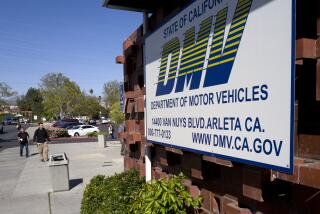Editorial: Ease up on California’s bar exam to achieve more diversity among lawyers
- Share via
California’s bar exam is notoriously difficult. Or, more to the point, it’s notoriously difficult to pass, which is not quite the same thing. The questions that prospective lawyers must answer aren’t necessarily harder here than those on other states’ exams, but the grading is tougher. It’s as if you only have to get a C+ to be an attorney in Illinois, but you need an A- in California. Fewer than half the would-be lawyers who took the test here in the last three years passed it.
That might be OK if it meant that California’s attorneys were more competent, and the public better protected against poor lawyering, than in other states. But there is no evidence to support any such contention. The pass rate, as set by the state, is relatively arbitrary.
The low pass rate would make sense if it turned out that fewer California test-takers were as capable or as prepared as their counterparts in other states. But that doesn’t appear to be the case either. The average California score on the multiple choice portion — the one part of the bar exam that is identical in most states — is higher than the national average.
An exam that significantly, if artificially, depresses the number of new attorneys each year might nevertheless have some appeal in a society that harbors at best a mixed level of enthusiasm about lawyers. So we have fewer of them than we might otherwise. Is that such a bad thing?
California and its residents have been poorly served by an unusually high bar exam cut score.
But there are indeed negative ramifications. It means California’s legal establishment is more exclusive than those in other jurisdictions, leaving out people who in almost any other state (only Delaware’s exam is as restrictive as California’s) could provide highly competent counsel to those who need it.
More specifically, the unusually high cut score — the term that the testing establishment gives to the line that separates those who pass from those who don’t — means California’s bar is disproportionately white.
A study of the July 2016 exam showed that reducing California’s cut score from 1440 to the national median of 1350 would have increased the number of successful African American exam-takers by 113%. There would have been a 75% increase in success for Latinos, and 58% for Asians. Of course more white exam-takers would have passed using the national median as well – 42% more. But the ranks of lawyers in this state would have been a bit more representative of the population that enters and graduates from law school, and the population of clients who need legal counsel.
Again, there is no evidence to suggest that lawyers in states with somewhat lower cut scores — including New York, where the line is set at 1330 — are any less competent than those in California. Once an applicant clears the bar that (somewhat arbitrarily) delineates minimum acceptable competence, ever-higher scores don’t appear to guarantee ever-finer attorneys or, to put it another way, better-served clients and public. It is noteworthy that California has long had something that the legal establishment calls a “unified bar” — meaning that the same agency responsible for licensing and disciplining attorneys just also happened to be the lawyers’ biggest trade association. This made for something of a conflict of interest. Attorneys would argue that they have a role in keeping professional standards high, and that may be true — but they also have a clear interest in keeping their numbers low. One way to accomplish that is to make the exam unreasonably difficult for would-be competitors to pass. That makes the exam more of an artificial barrier to entry, and a sort of hazing ritual, than a test of competence.
Things are about to change. Gov. Jerry Brown on Monday signed a bill to make the State Bar a strictly regulatory agency while spinning off the trade association into a private nonprofit. It’s a good step but will not by itself solve the problem of undue exclusivity that is caused by the bar exam’s atypical cut score.
Ultimately, it is the state Supreme Court that will decide this question. It is considering how to respond to a demand by the deans of most of the state’s largest accredited law schools to lower the score to something closer to the national mean.
The deans are right. California and its residents have been poorly served by an unusually high bar exam cut score. The court would be wise to adjust the cut score to something closer to the national average — and perhaps then commission a study to determine whether an exam based on early 20th-century methodologies actually determines a person’s fitness to practice law at all.
Follow the Opinion section on Twitter @latimesopinion and Facebook
More to Read
A cure for the common opinion
Get thought-provoking perspectives with our weekly newsletter.
You may occasionally receive promotional content from the Los Angeles Times.










